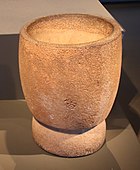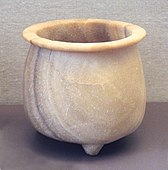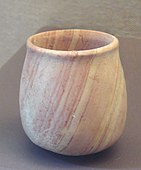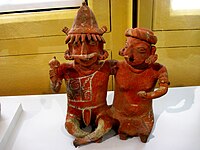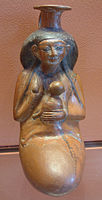Ceramic art
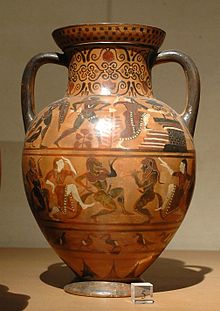

Ceramic art is art made from
In Britain and the United States, modern ceramics as an art took its inspiration in the early twentieth century from the
The word "ceramics" comes from the Greek keramikos (κεραμεικός), meaning "pottery", which in turn comes from keramos (κέραμος) meaning "potter's clay".
There is a long history of ceramic art in almost all developed cultures, and often ceramic objects are all the artistic evidence left from vanished cultures, like that of the Nok in Africa over 2,000 years ago. Cultures especially noted for ceramics include the Chinese, Cretan, Greek, Persian, Mayan, Japanese, and Korean cultures, as well as the modern Western cultures.
Elements of ceramic art, upon which different degrees of emphasis have been placed at different times, are the shape of the object, its decoration by painting, carving and other methods, and the glazing found on most ceramics.
Materials
Different types of clay, when used with different minerals and firing conditions, are used to produce earthenware, stoneware, porcelain and bone china (fine china).
Earthenware
Stoneware
Stoneware is a vitreous or semi-vitreous ceramic made primarily from stoneware clay or non-refractory fire clay.[10] Stoneware is fired at high temperatures.[11] Vitrified or not, it is nonporous;[12] it may or may not be glazed.[13]
One widely recognised definition is from the Combined Nomenclature of the European Communities, a European industry standard states "Stoneware, which, though dense, impermeable and hard enough to resist scratching by a steel point, differs from porcelain because it is more opaque, and normally only partially vitrified. It may be vitreous or semi-vitreous. It is usually coloured grey or brownish because of impurities in the clay used for its manufacture, and is normally glazed."[12]
Porcelain
Bone china
Developed by English potter
From its initial development and up to the later part of the twentieth century, bone china was almost exclusively an English product, with production being effectively localised in Stoke-on-Trent.[16]
Most major English firms made or still make it, including Mintons, Coalport, Spode, Royal Crown Derby, Royal Doulton, Wedgwood and Worcester. In the UK, references to "china" or "porcelain" can refer to bone china, and "English porcelain" has been used as a term for it, both in the UK and around the world.[18] Fine china is not necessarily bone china, and is a term used to refer to ware which does not contain bone ash.[12]
Surface treatments

Painting
China painting, or porcelain painting is the decoration of glazed
Slipware
Slipware is a type of pottery identified by its primary decorating process where slip is placed onto the leather-hard clay body surface before firing by dipping, painting or splashing. Slip is an aqueous suspension of a clay body, which is a mixture of clays and other minerals such as quartz, feldspar and mica. A coating of white or coloured slip, known as an engobe, can be applied to the article to improve its appearance, to give a smoother surface to a rough body, mask an inferior colour or for decorative effect. Slips or engobes can also be applied by painting techniques, in isolation or in several layers and colours. Sgraffito involves scratching through a layer of coloured slip to reveal a different colour or the base body underneath. Several layers of slip and/or sgraffito can be done while the pot is still in an unfired state. One colour of slip can be fired, before a second is applied, and prior to the scratching or incising decoration. This is particularly useful if the base body is not of the desired colour or texture.[20]
Terra sigillata

In sharp contrast to the archaeological usage, in which the term terra sigillata refers to a whole class of pottery, in contemporary ceramic art, 'terra sigillata' describes only a watery refined slip used to facilitate the burnishing of raw clay surfaces and used to promote carbon smoke effects, in both primitive low temperature firing techniques and unglazed alternative western-style Raku firing techniques. Terra sigillata is also used as a brushable decorative colourant medium in higher temperature glazed ceramic techniques.[21]
Forms
Studio pottery
Tile

A
Tiles are often used to form wall
Figurines
A figurine (a diminutive form of the word figure) is a statuette that represents a human, deity, legendary creature, or animal. Figurines may be realistic or iconic, depending on the skill and intention of the creator. The earliest were made of stone or clay. In ancient Greece, many figurines were made from terracotta (see Greek terracotta figurines). Modern versions are made of ceramic, metal, glass, wood and plastic. Figurines and
Tableware
Tableware is the dishes or dishware used for setting a table, serving food and dining. It includes cutlery, glassware, serving dishes and other useful items for practical as well as decorative purposes.[23][24] Dishes, bowls and cups may be made of ceramic, while cutlery is typically made from metal, and glassware is often made from glass or other non-ceramic materials. The quality, nature, variety and number of objects varies according to culture, religion, number of diners, cuisine and occasion. For example, Middle Eastern, Indian or Polynesian food culture and cuisine sometimes limits tableware to serving dishes, using bread or leaves as individual plates. Special occasions are usually reflected in higher quality tableware.[24]
Terracotta (artworks)
In addition to being a material, "terracotta" also refers to items made out of this material. In archaeology and art history, "terracotta" is often used to describe objects such as statues, and figurines not made on a potter's wheel. A prime example is the Terracotta Army, a collection of man-sized terracotta sculptures depicting the armies of Qin Shi Huang, the first Emperor of China. It is a form of funerary art buried with the emperor in 210–209 BCE and whose purpose was to protect the emperor in his afterlife.[25]
French sculptor Albert-Ernest Carrier-Belleuse made many terracotta pieces, but possibly the most famous is The Abduction of Hippodameia depicting the Greek mythological scene of a centaur kidnapping Hippodameia on her wedding day. American architect Louis Sullivan is well known for his elaborate glazed terracotta ornamentation, designs that would have been impossible to execute in any other medium. Terracotta and tile were used extensively in the town buildings of Victorian Birmingham, England.
History
There is a long history of ceramic art in almost all developed cultures, and often ceramic objects are all the artistic evidence left from vanished cultures, like that of the Nok in Africa over 3,000 years ago.[26] Cultures especially noted for ceramics include the Chinese, Cretan, Greek, Persian, Mayan, Japanese, and Korean cultures, as well as the modern Western cultures. There is evidence that pottery was independently invented in several regions of the world, including East Asia, Sub-Saharan Africa, the Near East, and the Americas.
Paleolithic pottery (c. 20,000 BP)

Although pottery figurines are found from earlier periods in Europe, the oldest pottery vessels come from East Asia, with finds in China and Japan, then still linked by a land bridge, and some in what is now the
Before Neolithic pottery: stone containers (12,000–6,000 BC)
Many remarkable containers were made from stone before the invention of pottery in
-
Stone mortar fromEynan, Natufian period, 12,500-9,500 BC
-
Calcite tripod vase, mid-Euphrates, probably from Tell Buqras, 6,000 BC, Louvre Museum AO 31551
-
Alabaster pot Mid-Euphrates region, 6,500 BC, Louvre Museum
-
Alabaster pot, Mid-Euphrates region, 6,500 BC, Louvre Museum
Neolithic pottery (6,500–3,500 BC)

Early pots were made by what is known as the "coiling" method, which worked the clay into a long string that wound to form a shape that later made smooth walls. The potter's wheel was probably invented in Mesopotamia by the 4th millennium BCE, but spread across nearly all Eurasia and much of Africa, though it remained unknown in the New World until the arrival of Europeans. Decoration of the clay by incising and painting is found very widely, and was initially geometric, but often included figurative designs from very early on.
So important is pottery to the archaeology of prehistoric cultures that many are known by names taken from their distinctive, and often very fine, pottery, such as the
Ceramic art has generated many styles from its own tradition, but is often closely related to contemporary sculpture and metalwork. Many times in its history styles from the usually more prestigious and expensive art of metalworking have been copied in ceramics. This can be seen in early Chinese ceramics, such as pottery and ceramic-wares of the Shang dynasty, in Ancient Roman and Iranian pottery, and
Ceramics as wall decoration

The earliest evidence of glazed brick is the discovery of glazed bricks in the
Using the
Transmitted via Islamic Iberia, a new tradition of Azulejos developed in Spain and especially Portugal, which by the Baroque period produced extremely large painted scenes on tiles, usually in blue and white. Delftware tiles, typically with a painted design covering only one (rather small) tile, were ubiquitous in the Netherlands and widely exported over Northern Europe from the 16th century on. Several 18th-century royal palaces had porcelain rooms with the walls entirely covered in porcelain. Surviving examples include ones at Capodimonte, Naples, the Royal Palace of Madrid and the nearby Royal Palace of Aranjuez.[37] Elaborate cocklestoves were a feature of rooms of the middle and upper-classes in Northern Europe from the 17th to 19th centuries.
There are several other types of traditional tiles that remain in manufacture, for example, the small, almost mosaic, brightly coloured
Regional developments
Although pottery figurines are found from earlier periods in Europe, the oldest pottery vessels come from East Asia, with finds in China and Japan, then still linked by a land bridge, and some in what is now the
Cambodia
Recent archaeological excavations at
Glazed wares first appear in the archaeological record at the end of the 9th century at the Roluos temple group in the Angkor region, where green-glazed pot shards have been found. A brown glaze became popular at the beginning of the 11th century and brown-glazed wares have been found in abundance at Khmer sites in northeast Thailand. Decorating pottery with animal forms was a popular style from the 11th to 13th century. Archaeological excavations in the Angkor region have revealed that towards the end of Angkor period production of indigenous pottery declined while there was a dramatic increase in Chinese ceramic imports.
Direct evidence of the shapes of vessels is provided by scenes depicted on bas-reliefs at Khmer temples, which also offer insight into domestic and ritualistic uses of the wares. The wide range of utilitarian shapes suggest the Khmers used ceramics in their daily life for cooking, food preservation, carrying and storing liquids, as containers for medicinal herbs, perfumes and cosmetics.[38]
China

There is
Some experts believe the first true porcelain was made in the
The Imperial porcelain of the Song dynasty (960–1279), featuring very subtle decoration shallowly carved by knife in the clay, is regarded by many authorities as the peak of Chinese ceramics, though the large and more exuberantly painted ceramics of the Ming dynasty (1368–1644) have a wider reputation.
Chinese emperors gave ceramics as diplomatic gifts on a lavish scale, and the presence of Chinese ceramics no doubt aided the development of related traditions of ceramics in Japan and Korea in particular.
Until the 16th century, small quantities of expensive
Japan


The earliest Japanese pottery was made around the 11th millennium BCE.
In the 17th century, conditions in China drove some of its potters into Japan, bringing with them the knowledge to make refined porcelain. From the mid-century, the
In the 20th century, interest in the art of the village potter was revived by the
Korea
Korean pottery has had a continuous tradition since simple earthenware from about 8000 BCE. Styles have generally been a distinctive variant of Chinese, and later Japanese, developments. The celadon Goryeo ware from the Goryeo dynasty (918–1392) and early Joseon white porcelain of the following dynasty are generally regarded as the finest achievements.[43]
Western Asia and the Middle East
Islamic pottery

From the 8th to 18th centuries, glazed ceramics was important in Islamic art, usually in the form of elaborate pottery,[44] developing on vigorous Persian and Egyptian pre-Islamic traditions in particular. Tin-opacified glazing was developed by the Islamic potters, the first examples found as blue-painted ware in Basra, dating from about the 8th century. The Islamic world had contact with China, and increasingly adapted many Chinese decorative motifs. Persian wares gradually relaxed Islamic restrictions on figurative ornament, and painted figuratives scenes became very important.

Stoneware was also an important craft in Islamic pottery, produced throughout Iraq and Syria by the 9th century.[45] Pottery was produced in Raqqa, Syria, in the 8th century.[46] Other centers for innovative ceramics in the Islamic world were Fustat (near modern Cairo) from 975 to 1075, Damascus from 1100 to around 1600 and Tabriz from 1470 to 1550.[47]
The
Europe
Early figurines
The earliest known ceramic objects are the
The ancient Mediterranean
Glazed
On the Greek
Ancient Greek and Etruscan ceramics are renowned for their figurative painting, especially in the black-figure and red-figure styles. Moulded Greek terracotta figurines, especially those from Tanagra, were small figures, often religious but later including many of everyday genre figures, apparently used purely for decoration.
Tin-glazed pottery

Porcelain
Until the 16th century, small quantities of expensive
Porcelain was ideally suited to the energetic
By the end of the 18th century owning porcelain tableware and decorative objects had become obligatory among the prosperous middle-classes of Europe, and there were factories in most countries, many of which are still producing. As well as tableware, early European porcelain revived the taste for purely decorative figures of people or animals, which had also been a feature of several ancient cultures, often as
Wedgwood and the North Staffordshire Potteries
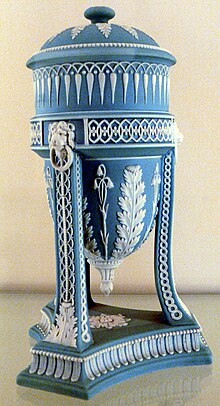
From the 17th century,
The local presence of abundant supplies of coal and suitable clay for earthenware production led to the early but at first limited development of the local pottery industry. The construction of the Trent and Mersey Canal allowed the easy transportation of china clay from Cornwall together with other materials and facilitated the production of creamware and bone china. Other production centres had a lead in the production of high quality wares but the preeminence of North Staffordshire was brought about by methodical and detailed research and a willingness to experiment carried out over many years, initially by one man, Josiah Wedgwood. His lead was followed by other local potters, scientists and engineers.
Wedgwood is credited with the
He also is credited with perfecting
Far from perfecting underglaze print Wedgwood was persuaded by his painters not to adopt underglaze printing until it became evident that Mr Spode was taking away his business through competitive pricing for a much more heavily decorated high quality product.
Stoke-on-Trent's supremacy in pottery manufacture nurtured and attracted a large number of ceramic artists including Clarice Cliff, Susie Cooper, Lorna Bailey, Charlotte Rhead, Frederick Hurten Rhead and Jabez Vodrey.
Studio pottery in Britain
Pottery in Germany
German pottery has its roots in the alchemistry laboratories searching for gold production.
- Royal Porcelain Factory, Berlin
- Meissen porcelain
- Nymphenburg porcelain[61]
- Hutschenreuther
Pottery in Austria
In 1718 a pottery was founded in Vienna.[62]
Pottery in Russia
The
The Americas
Native American pottery
The people in North, Central, and South America continents had a wide variety of pottery traditions before Europeans arrived. The oldest ceramics known in the
The best-developed styles found in the central and southern Andes are the ceramics found near the ceremonial site at Chavín de Huántar (800–400 BCE) and Cupisnique (1000–400 BCE). During the same period, another culture developed on the southern coast of Peru, in the area called Paracas. The Paracas culture (600–100 BCE) produced marvelous works of embossed ceramic finished with a thick oil applied after firing. This colorful tradition in ceramics and textiles was followed by the Nazca culture (1–600 CE), whose potters developed improved techniques for preparing clay and for decorating objects, using fine brushes to paint sophisticated motifs. In the early stage of Nazca ceramics, potters painted realistic characters and landscapes.
The
The
In the United States, the oldest pottery dates to 2500 BCE. It has been found in the Timucuan Ecological and Historic Preserve in Jacksonville, Florida, and some slightly older along the Savannah River in Georgia.[67]
The
Mexican ceramics
Studio pottery in the United States
There is a strong tradition of studio artists working in ceramics in the United States. It had a period of growth in the 1960s and continues to present times. Many fine art, craft, and contemporary art museums have pieces in their permanent collections. Beatrice Wood was an American artist and studio potter located in Ojai, California. She developed a unique form of luster-glaze technique, and was active from the 1930s to her death in 1998 at 105 years old. Robert Arneson created larger sculptural work, in an abstracted representational style. There are ceramics arts departments at many colleges, universities, and fine arts institutes in the United States.
Sub-Saharan Africa
It appears that pottery was independently developed in Sub-Saharan Africa during the 10th millennium BC, with findings dating to at least 9,400 BC from central Mali.[69] In Africa, the earliest pottery has been found in the large mountain massifs of the Central Sahara, in the Eastern Sahara, and the Nile Valley, dating back to between the ninth and tenth millennium.[70]
Pottery in Sub-Saharan Africa is traditionally made by coiling and is fired at low temperature. The figurines of the ancient
In the Aïr Region of Niger (West Africa) (Haour 2003) pottery dating from around 10,000 BCE was excavated.[71]
Ceramics museums and museum collections
A ceramics museum is a museum wholly or largely devoted to ceramics, normally ceramic artworks, whose collections may include glass and enamel as well, but will usually concentrate on pottery, including porcelain. Most national ceramics collections are in a more general museum covering all the arts, or just the decorative arts, but there are a number of specialized ceramics museums, some concentrating on the production of just one country, region or manufacturer. Others have international collections, which may concentrate on ceramics from Europe or East Asia, or have global coverage.
In Asian and Islamic countries ceramics are usually a strong feature of general and national museums.[
Outstanding major ceramics collections in general museums include
-
100 BCE – 250 CE
-
Ceramic goblet from Navdatoli, Malwa, India, 1300 BCE; Malwa culture
-
A funerary urn in the shape of a "bat god" or a jaguar, from Oaxaca, Mexico, dated to 300–650 CE. Height: 9.5 in (23 cm).
-
Luca della Robbia the Young, Virgin and Child with John the Baptist
-
18th centurySt Petersburg
See also
- American Museum of Ceramic Art – ceramic Art Museum in Pomona, California
- List of studio potters
- Sculpture – Artworks that are three-dimensional objects
- Visual arts – Art forms that create works that are primarily visual in nature
References
Citations
- ^ "Art Pottery Manufacturers and Collectors". Archived from the original on 2 June 2008. Retrieved 5 January 2003.
- ^ "California Art Pottery, 1895-1920" Scholar Works, California State University
- ^ The Webster Encyclopedic Dictionary
- ^ "Earthenware" Britannica online
- OED, "Terracotta"
- ^ 'Diagnosis Of Terra-Cotta Glaze Spalling.' S.E. Thomasen, C.L. Searls. Masonry: Materials, Design, Construction and Maintenance. ASTM STP 992 Philadelphia, USA, 1988. American Society for Testing & Materials.
- ^ 'Colour Degradation In A Terra Cotta Glaze' H.J. Lee, W.M. Carty, J.Gill. Ceram.Eng.Sci.Proc. 21, No.2, 2000, p. 45–58.
- ^ 'High-lead glaze compositions and alterations: example of byzantine tiles.' A. Bouquillon. C. Pouthas. Euro Ceramics V. Pt.2. Trans Tech Publications, Switzerland,1997, p. 1487–1490 Quote: "A collection of architectural Byzantine tiles in glazed terra cotta is stored and exhibited in the Art Object department of the Louvre Museum as well as in the Musee de la Ceramique de Sevres."
- ^ 'Industrial Ceramics.' F.Singer, S.S.Singer. Chapman & Hall. 1971. Quote: "The lighter pieces that are glazed may also be termed 'terracotta.'
- ^ Standard Terminology of Ceramic Whiteware and Related Products: ASTM Standard C242.
- ^ "What Temperature Should I Fire My Clay To?". bigceramicstore.com. Retrieved 19 March 2016.
- ^ a b c d Dodd 1994.
- ^ Encyclopædia Britannica Jasperware is unglazed stoneware
- ^ Definition in The Combined Nomenclature of the European Communities defines, Burton, 1906
- ^ a b Ozgundogdu, Feyza Cakir. "Bone China from Turkey" Ceramics Technical; May2005, Issue 20, p 29–32.
- ^ a b 'Trading Places.' R.Ware. Asian Ceramics. November, 2009, p.35,37-39.
- ^ What is China? As with stoneware, the body becomes vitrified; which means the body fuses, becomes nonabsorbent, and very strong. Unlike stoneware, china becomes very white and translucent. Archived 14 June 2015 at the Wayback Machine
- ISBN 1-136-80192-8, 781136801921
- ^ Lewis, Florence (1883). China painting. Cassell.
- ISBN 90-5703-212-0
- ^ Garbsch, Jochen, Terra Sigillata. (1982) Ein Weltreich im Spiegel seines Luxusgeschirrs, Munich. (in German)
- ^ a b Cooper 2010.
- ISBN 978-1-4081-5395-6.
- ^ ISBN 978-0-8109-6692-5.
- ISBN 978-0-674-02697-1.
- ^ Breunig, Peter. 2014. Nok: African Sculpture in Archaeological Context: p. 21.
- ^ Huan, Anthony (13 April 2019). "Ancient China: Neolithic". National Museum of China.
- ^ S2CID 37666548.
- .
- ^ a b "BBC NEWS – Science & Environment – 'Oldest pottery' found in China". bbc.co.uk. June 2009. Retrieved 19 March 2016.
- ^ PMID 19487667.
- ^ a b "Harvard, BU researchers find evidence of 20,000-year-old pottery". Boston.com. Archived from the original on 2 January 2013. Retrieved 2 January 2013.
- ^ a b Stanglin, Douglas (29 June 2012). "Pottery found in China cave confirmed as world's oldest". USA Today.
- ^ "Metropolitan Museum of Art". www.metmuseum.org.
- ISBN 978-0-89236-758-0– via Google Books.
- ^ "Qantara – Mihrāb of the Great Mosque of Kairouan". qantara-med.org. Archived from the original on 3 March 2016. Retrieved 19 March 2016.
- ^ Porcelain Room, Aranjuez Comprehensive but shaky video [dead link]
- ^ "Contact Support". cambodiamuseum.info. Retrieved 19 March 2016.
- ^ "Celadon". Britannica Online. Archived from the original on 22 December 2007.
- ISBN 0-500-23727-1.
- ISBN 978-0-233-00202-6
- ^ The Metropolitan Museum of Art [1] "Although the roots of Sueki reach back to ancient China, its direct precursor is the grayware of the Three Kingdoms period in Korea."
- ^ "Collection: Korean Art". Freer/Sackler. Smithsonian Institution. Archived from the original on 1 September 2015. Retrieved 2 August 2015.
- ) Mason (1995), p. 1
- ^ Mason (1995), p. 5
- .
- ^ Mason (1995), p. 7
- ^ "No. 359: The Dolni Vestonice Ceramics". uh.edu. Retrieved 19 March 2016.
- ISBN 978-0-7139-9795-8.
- ^ "Archaeological site of akrotiri Santorini Greece". travel-to-santorini.com. Retrieved 19 March 2016.
- ^ Caiger-Smith, Alan, Tin Glazed Pottery, Faber and Faber, 1973
- ^ "สล็อตเว็บตรง เว็บแท้ไม่มีขั้นต่ำ รวมเกมสล็อตแตกง่ายทุกค่าย". Archived from the original on 13 April 2005.
- ^ 'Ceramic Glazes.' F.Singer & W.L.German. Borax Consolidated Limited. London. 1960.
- ^ 'Ceramics Glaze Technology.' J.R. Taylor & A.C. Bull. The Institute Of Ceramics & Pergamon Press. Oxford. 1986.
- ISBN 0-521-83833-9
- ^ "The 18th Century: The Rise and Success". Manufacture nationale de Sèvres. Archived from the original on 24 November 2006.
- ^ "Sèvres Porcelain in the Nineteenth Century". The Met's Heilbrunn Timeline of Art History. Retrieved 19 March 2016.
- ^ "French Porcelain in the Eighteenth Century". The Met's Heilbrunn Timeline of Art History. Retrieved 19 March 2016.
- ^ "all about Stoke-on-Trent in 5 minutes..." thepotteries.org. Retrieved 19 March 2016.
- ^ Harrod, Tanya, "From A Potter's Book to The Maker's Eye: British Studio Ceramics 1940–1982", in The Harrow Connection, Northern Centre for Contemporary Art, 1989
- ^ "HISTORY Porzellan Manufaktur Nymphenburg". Retrieved 24 July 2016.
- ^ "Porcelain Museum in the Augarten". Archived from the original on 12 August 2016. Retrieved 25 July 2016.
- ^ "Imperial Porcelain: The History of Russian Imperial Porcelain from 1744 to 1917*". Archived from the original on 26 March 2016. Retrieved 25 July 2016.
- ^ The New York Times, Art Review Museum of American Indian's 'Born of Clay' Explores Culture Through Ceramics By GRACE GLUECK, Published: 1 July 2006
- ^ Born of Clay – Ceramic from the National Museum of the American Indian, 2005 Smithsonian Institution
- ^ C.M. Hogan, Comparison of Mayan sites in southern and western Belize, Lumina Technologies (2006)
- ^ Soergel, Matt (18 October 2009). "The Mocama: New name for an old people". The Florida Times-Union. Retrieved 12 May 2010.
- ^ A Nampeyo Showcase Archived 24 September 2015 at the Wayback Machine, a display of some of Nampeyo's work
- ^ Simon Bradley, A Swiss-led team of archaeologists has discovered pieces of the oldest African pottery in central Mali, dating back to at least 9,400BC Archived 2012-03-06 at the Wayback Machine, SWI swissinfo.ch – the international service of the Swiss Broadcasting Corporation (SBC), 18 January 2007
- ISSN 1612-1651.
- ISBN 978-1-4020-4559-2.
- ^ "Archaeological Analysis", Ohio State Archeological excavations in Greece
- ^ "Palace Museum Opens Its New Porcelain Hall". chinaculture.org. Archived from the original on 3 March 2016. Retrieved 19 March 2016.
- ^ "國立故宮全球資訊網-訊息頁". npm.gov.tw. Retrieved 19 March 2016.
- ^ Peterson 1996, p. 369.
- ^ "Le collezioni".
Sources
- OCLC 42475956.
- Cooper, Emmanuel (1989). A History of World Pottery. ISBN 978-0-8019-7982-8.
- Howard, Coutts (2001). The Art of Ceramics: European Ceramic Design 1500–1830. Yale University Press. ISBN 978-0-517-53931-6.
- Dinsdale, Allen (1986). Pottery Science. Ellis Horwood, Ltd. ISBN 978-0-470-20276-0.
- Dodd, Arthur (1994). Dictionary of Ceramics: Pottery, Glass, Vitreous Enamels, Refractories, Clay Building Materials, Cement and Concrete, Electroceramics, Special Ceramics. Maney Publishing. ISBN 978-0-901716-56-9.
- Levin, Elaine (1988). The History of American Ceramics: From Pipkins and Bean Pots to Contemporary Forms, 1607 to the present. Harry N. Abrams. ISBN 978-0-8109-1172-7.
- Perry, Barbara (1989). American Ceramics: The Collection of Everson Museum of Art. Rizzoli. ISBN 978-0-8478-1025-3.
- OCLC 604392596– via Internet Archive.
- George, Savage; Newman, Harold (2000). Illustrated Dictionary of Ceramics. Thames & Hudson. ISBN 978-0-500-27380-7.
External links
- Ceramic from the Victoria & Albert Museum
- Ceramic history for potters by Victor Bryant
- Index to the Metropolitan Museum Timeline of Art History – see "ceramics" for many features
- Minneapolis Institute of Arts: Ceramics – The Art of Asia* Potweb Online catalogue & more from the Ashmolean Museum
- Stoke-on-Trent Museums – Ceramics Online
- Royal Dutch Ceramics
- UK Ceramics Information – British Ceramic Brands

